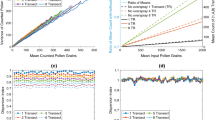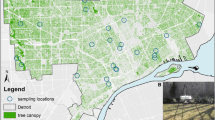Abstract
We describe a method for constructing prediction models for daily pollen concentrations of several pollen taxa in different measurement sites in Switzerland. The method relies on daily pollen concentration time series that were measured with Hirst samplers. Each prediction is based on the weather conditions observed near the pollen measurement site. For each prediction model, we do model assessment with a test data set spanning several years.





Similar content being viewed by others
References
Arizmendi, C., Sanchez, J., Ramos, N., & Ramos, G. (1993). Time series predictions with neural nets: Application to airborne pollen forecasting. International Journal of Biometeorology, 37(3):139–144.
Belmonte, J., & Canela, M. (2002). Modelling aerobiological time series. Application to Urticaceae. Aerobiologia, 18(3):287–295.
Belmonte, J., Canela, M., Guardia, R., Guardia, R., Sbai, L., Vendrell, M., et al. (1999). Aerobiological dynamics of the UrticSaceae pollen in Spain, 1992–98. Polen, 10, 79–91.
Boyer, W. (1973). Air temperature, heat sums, and pollen shedding phenology of longleaf pine. Ecology, 54(2), 420–426.
Breiman, L. (1984). Classification and regression trees. London/Boca Raton, FL: Chapman & Hall/CRC.
Bringfelt, B., Engström, I., & Nilsson, S. (1982). An evaluation of some models to predict airborne pollen concentration from meteorological conditions in Stockholm, Sweden. Grana, 21(1), 59–64.
Cameron, A., & Windmeijer, F. (1996). R-squared measures for count data regression models with applications to health-care utilization. Journal of Business & Economic Statistics, 14(2), 209–220.
Castellano-Méndez, M., Aira, M., Iglesias, I., Jato, V., & González-Manteiga, W. (2005). Artificial neural networks as a useful tool to predict the risk level of betula pollen in the air. International Journal of Biometeorology, 49(5), 310–316.
Clot, B. (2001). Airborne birch pollen in Neuchâtel (Switzerland): Onset, peak and daily patterns. Aerobiologia, 17(1), 25–29.
Comtois, P., Alcazar, P., & Neron, D. (1999). Pollen counts statistics and its relevance to precision. Aerobiologia, 15(1), 19–28.
Comtois, P., & Sherknies, D. (1991). Pollen curves typology. Grana, 30(1), 184–189.
Cotos-Yáñez, T., Rodriguez-Rajo, F., & Jato, M. (2004). Short-term prediction of betula airborne pollen concentration in Vigo (NW Spain) using logistic additive models and partially linear models. International Journal of Biometeorology, 48(4), 179–185.
Cox, C., & Wathes, C. (1995). Bioaerosols handbook. USA: Lewis publishers.
Frenguelli, G., & Bricchi, E. (1998). The use of the pheno-climatic model for forecasting the pollination of some arboreal taxa. Aerobiologia, 14(1), 39–44.
Friedman, J. (1984). A variable span smoother. Department of Statistics. Technical report. Stanford, CA: Stanford University.
Friedman, J. (1991). Multivariate adaptive regression splines. The Annals of Statistics, 19(1), 1–67.
Friedman, J. (2001). Greedy function approximation: A gradient boosting machine. Annals of Statistics, 29(5), 1189–1232.
Friedman, J. (2002). Stochastic gradient boosting. Computational Statistics & Data Analysis, 38(4), 367–378.
Galán, C., Cariñanos, P., García-Mozo, H., Alcázar, P., & Domínguez-Vilches E. (2001) Model for forecasting Olea europaea L. airborne pollen in South–West Andalusia, Spain. International journal of biometeorology, 45(2), 59–63.
Gregory, P. (1961). The microbiology of the atmosphere. London: Leonard Hill.
Hirst, J. (1952). An automatic volumetric spore trap. Annals of Applied Biology, 39(2), 257–265.
Isard, S., & Gage, S. (2001). Flow of life in the atmosphere: An airscape approach to understanding invasive organisms. East Lansing: Michigan State University Press.
Kasprzyk, I., & Walanus, A. (2010). Description of the main poaceae pollen season using bi-Gaussian curves, and forecasting methods for the start and peak dates for this type of season in rzeszów and ostrowiec św. (SE Poland). Journal of Environmental Monitoring, 12(4), 906–916.
Makra, L., Juhász, M., Borsos, E., & Béczi, R. (2004). Meteorological variables connected with airborne ragweed pollen in southern Hungary. International Journal of Biometeorology, 49(1), 37–47.
Mandrioli, P., Comtois, P., & Levizzani, V. (1998). Methods in aerobiology. Bologna: Pitagora Editrice.
Norris-Hill, J. (1995). The modelling of daily Poaceae pollen concentrations. Grana, 34(3), 182–188.
Pauling, A., Rotach, M., Gehrig, R., & Clot, B. (2011). A method to derive vegetation distribution maps for pollen dispersion models using birch as an example. International Journal of Biometeorology, 1–10.
Peeters, A., Clot, B., Gehrig, R., et al. (1998). Luftpollengehalt in der schweiz. Zürich, Switzerland: SMA–Schweizerische Meteorologische Anstalt.
Peng, R. (2008). A method for visualizing multivariate time series data. Journal of Statistical Software 25(1), 1–17.
R Development Core Team (2010). R: A Language and Environment for Statistical Computing. Vienna: R Foundation for Statistical Computing. ISBN 3-900051-07-0.
Ranzi, A., Lauriola, P., Marletto, V., & Zinoni, F. (2003) Forecasting airborne pollen concentrations: Development of local models. Aerobiologia 19(1), 39–45.
Ridgeway, G. (2007). gbm: Generalized boosted regression models. R package version 1.6-3.
Rodriguez-Rajo, F., Frenguelli, G., & Jato, M. (2003). Effect of air temperature on forecasting the start of the betula pollen season at two contrasting sites in the south of Europe (1995–2001). International Journal of Biometeorology, 47(3), 117–125.
Schwartz, M. (2003). Phenology: An integrative environmental science. Dordrecht: Kluwer Academic Publishers.
Smith, M., & Emberlin, J. (2006). A 30-day-ahead forecast model for grass pollen in north London, United Kingdom. International Journal of Biometeorology, 50(4), 233–242.
Spieksma, F., Corden, J., Detandt, M., Millington, W., Nikkels, H., Nolard, N., et al. (2003). Quantitative trends in annual totals of five common airborne pollen types (betula, quercus, poaceae, urtica, and artemisia), at five pollen-monitoring stations in western Europe. Aerobiologia, 19(3), 171–184.
Spieksma, M., Emberlin, J., Hjelmroos, M., Jäger, S., & Leuschner, R. (1995). Atmospheric birch (Betula) pollen in Europe: Trends and fluctuations in annual quantities and the starting dates of the seasons. Grana, 34(1), 51–57.
Stach, A., Smith, M., Prieto Baena, J., & Emberlin, J. (2008) Long-term and short-term forecast models for poaceae (grass) pollen in Poznan, Poland, constructed using regression analysis. Environmental and Experimental Botany, 62(3), 323–332.
Stark, P., Ryan, L., McDonald, J., & Burge, H. (1997). Using meteorologic data to predict daily ragweed pollen levels. Aerobiologia, 13(3), 177–184.
Voukantsis, D., Niska, H., Karatzas, K., Riga, M., Damialis, A., & Vokou, D. (2010). Forecasting daily pollen concentrations using data-driven modeling methods in Thessaloniki, Greece. Atmospheric Environment, 44(39), 5101–5111.
Acknowledgments
The authors would like to thank Katrin Zink for helping to improve the readability of the text.
Author information
Authors and Affiliations
Corresponding author
Rights and permissions
About this article
Cite this article
Hilaire, D., Rotach, M.W. & Clot, B. Building models for daily pollen concentrations. Aerobiologia 28, 499–513 (2012). https://doi.org/10.1007/s10453-012-9252-4
Received:
Accepted:
Published:
Issue Date:
DOI: https://doi.org/10.1007/s10453-012-9252-4




